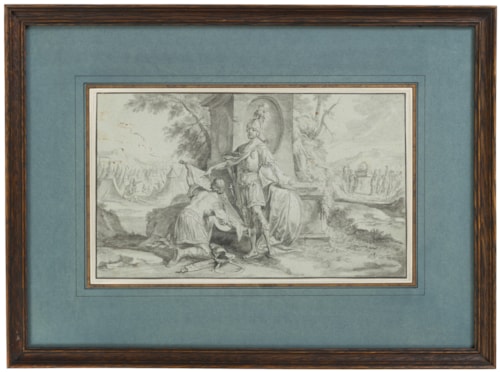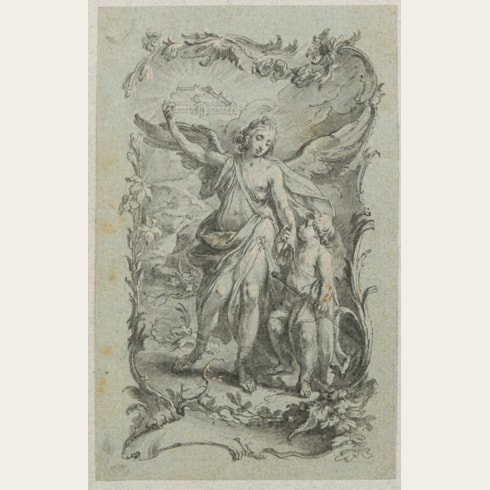Johann Wolfgang BAUMGARTNER
(Ebbs 1702 - Augsburg 1761)
Joshua Outside the Walls of Jericho
Sold
Pen and black ink and grey wash, heightened with white, on blue paper, with framing lines in black ink.
Inscribed Joh: Wolfgang Baumgärtner 1712-1761. / /Kufstein./ and B in black ink on the album page to which the present sheet was formerly attached.
175 x 293 mm. (6 7/8 x 11 1/2 in.)
Inscribed Joh: Wolfgang Baumgärtner 1712-1761. / /Kufstein./ and B in black ink on the album page to which the present sheet was formerly attached.
175 x 293 mm. (6 7/8 x 11 1/2 in.)
As one scholar has noted, ‘[A] colourful blend of Christian and pagan themes, sacred and profane motifs, witty allegories and realistic genre scenes, is characteristic of Baumgartner’s entire drawn oeuvre… Baumgartner’s works impress with their wealth of ideas and innovations.’
The present sheet is likely to have been a design for a print. It has been suggested that the subject depicts an episode from the Battle of Jericho, as recorded in the Old Testament Book of Joshua (6:1-20). Joshua, the leader of the Israelites, is seen here studying a plan of the city of Jericho, with the Israelites encamped outside the walls of the city in the left background. In the right background may be seen seven priests with trumpets carrying the Ark of the Covenant around the city. According to the Biblical account, God commanded the Israelites to carry the Ark around the walls of Jericho once a day for six days, and then seven times on the seventh day. In each circumnavigation of the city, the Ark of the Covenant was preceded by seven priests, each sounding a trumpet of rams’ horns. On the final day, after the seventh circuit, the walls of Jericho crumbled to the ground, and the Israelites conquered the city.
The present sheet is likely to have been a design for a print. It has been suggested that the subject depicts an episode from the Battle of Jericho, as recorded in the Old Testament Book of Joshua (6:1-20). Joshua, the leader of the Israelites, is seen here studying a plan of the city of Jericho, with the Israelites encamped outside the walls of the city in the left background. In the right background may be seen seven priests with trumpets carrying the Ark of the Covenant around the city. According to the Biblical account, God commanded the Israelites to carry the Ark around the walls of Jericho once a day for six days, and then seven times on the seventh day. In each circumnavigation of the city, the Ark of the Covenant was preceded by seven priests, each sounding a trumpet of rams’ horns. On the final day, after the seventh circuit, the walls of Jericho crumbled to the ground, and the Israelites conquered the city.
Born near Kufstein in the Tyrol, Johann Wolfgang Baumgartner was the son of a blacksmith and became one of the leading artists of the Rococo in Southern Germany. He began his career in Salzburg as a hinterglasmalerei; a method of painting decorative compositions on the reverse of glass panels. Although they were highly prized, very few of these precious works have survived. After travelling in Italy, Austria, Hungary and Bohemia, Baumgartner settled in 1731 in Augsburg, where he was associated with the local Kunstakademie, and was able to work as an independent artist from 1733 onwards. At first, however, he was only permitted to work as a hinterglasmaler, although since he was the only artist in the Swabian imperial city working in this technique, he achieved some renown. It was not until 1745, when he became a citizen of Augsburg and joined the local guild of painters, that he began working in both oil painting and fresco. His earliest known work in fresco dates from 1754, when he decorated the ceiling of the church of St. Jakobus in Gersthofen, for which he also painted several altarpieces. In 1756 he frescoed the Heilige Kreuz church in the village of Bergen, near Neuberg an der Donau, followed two years later by work in the Loretokirche in Augsburg. Soon established as one of the leading artists in Augsburg, Baumgartner painted numerous ceilings and frescoes for churches in Southern Germany, notably at Egenhausen, Bergen and Baitenhausen. He also worked for the Prince-Bishop Cardinal Franz Konrad von Rodt in the garden pavilion of the Neue Residenz at Meersburg, on Lake Constance, although further work there was left unfinished by his death from tuberculosis in September 1761.
Baumgartner is best known today as a draughtsman and designer of prints – ‘one of the most gifted designers for the print trade that Augsburg produced in a fertile period of graphic invention’, according to one modern scholar - although unusually he does not seem to have worked as a printmaker himself. Some 220 drawings by the artist have survived, most of which served as designs for prints, book illustrations or calendars for the three leading publishing houses in Augsburg of Klauber, Engelbrecht and Kilian. The artist worked particularly closely with the brothers Johann Baptist and Joseph Sebastian Klauber, printmakers and publishers who etched many of his designs. Baumgartner’s model drawings for engravings include allegorical, mythological and religious subjects, genre scenes, hunting themes and elegant pastoral subjects, as well as designs for Thesenblätter, or thesis frontispieces. (Interestingly, many of Baumgartner’s preparatory designs for prints were in the form of oil sketches on canvas, often much larger in scale than the final engraving; this was probably a legacy of his work as a glass painter.) Among his significant commissions as a book illustrator, Baumgartner provided some three hundred designs for Joseph Giulini’s devotional work Tägliche Erbauung eines wahren Christen (Daily Devotions of a True Christian); a calendar illustrating each of the days of the year with an engraving of different saint.
Baumgartner is best known today as a draughtsman and designer of prints – ‘one of the most gifted designers for the print trade that Augsburg produced in a fertile period of graphic invention’, according to one modern scholar - although unusually he does not seem to have worked as a printmaker himself. Some 220 drawings by the artist have survived, most of which served as designs for prints, book illustrations or calendars for the three leading publishing houses in Augsburg of Klauber, Engelbrecht and Kilian. The artist worked particularly closely with the brothers Johann Baptist and Joseph Sebastian Klauber, printmakers and publishers who etched many of his designs. Baumgartner’s model drawings for engravings include allegorical, mythological and religious subjects, genre scenes, hunting themes and elegant pastoral subjects, as well as designs for Thesenblätter, or thesis frontispieces. (Interestingly, many of Baumgartner’s preparatory designs for prints were in the form of oil sketches on canvas, often much larger in scale than the final engraving; this was probably a legacy of his work as a glass painter.) Among his significant commissions as a book illustrator, Baumgartner provided some three hundred designs for Joseph Giulini’s devotional work Tägliche Erbauung eines wahren Christen (Daily Devotions of a True Christian); a calendar illustrating each of the days of the year with an engraving of different saint.






